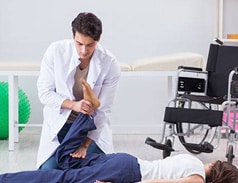Do you sometimes have pain in your knee during running or walking? Or are you looking at increasing your activity and want to prevent future injuries? If you answered yes to one of these questions, tune in to learn more!
Hi, my name is Angela from Miami and Lakelands Physiotherapy and I am here to talk more about dynamic knee valgus (the sideways angle of your knee) and how it increases risk of injury during running or sports.
So what is dynamic knee valgus?
Knee valgus is a knee position that looks like the “knock knees”. This knee position can be something we are genetically more predisposed to – that is it is how your bones are made up and how you stand. Sometimes your knee position is normal at rest, but when you move you move with your knees in a “knock knees”. This “dynamic knee valgus” is caused by the lack of strength and control of your hip and knee muscles. Research has shown that increased dynamic knee valgus increases your risk of ACL injuries and other lower leg injuries. It also puts more load onto your lower limb joints, which has the potential to cause patellofemoral pain and joint pain due to excessive loading.
How do we know if we have a dynamic knee valgus?
One of the easiest ways to identify if you have decreased motor control is doing squats or sit to stand. When you are trying to stand up from sitting, look at your knee position. For some people, you can start seeing your knees going inwards, causing that knocked knee look. This test can also be done when doing a squat. If you are someone who runs and plays competitive sports, however, it is not enough to not have increased knee valgus when doing sit to stand or double legged squat, we need to be able to have good knee control when doing single legged squats and single leg jumps.
Learn how you can perform a proper squat.
If you have tried these tests and can see that you have dynamic knee valgus, or you’ve had previous ACL injuries, or discomfort at your knees, come to Miami Physiotherapy for a thorough check up and a personalized rehab plan. Keep reading to learn how to start your journey to achieving better knee control.
How do you fix a dynamic knee valgus? Exercises & Tips
There is no “one size fits all” exercise when it comes to motor control training. It is important to figure out your level of activity and the demands of your sport and life to determine the level of knee control you need to achieve. After that, we would need to determine a good starting point by seeing what exercise is the best fit – it needs to be challenging enough but not too hard at the same time. If you notice that your knee knocks inwards when you are doing a sit to stand, start your exercise by doing a sit to stand while keeping your knee in line with your hip and foot. This also applies if you have trouble with double legged squatting or even single legged squatting – the best exercises are the exercises that are functional and relevant to you. The exercises need to be progressed with time as we need progression to gradually get closer to your goal.
It is highly recommendable that you work with a professional for motor control training, as it is challenging to find your perfect regime by yourself. Visit us at the Miami or Lakelands physiotherapy clinic for a thorough assessment and a personalized rehab program.

